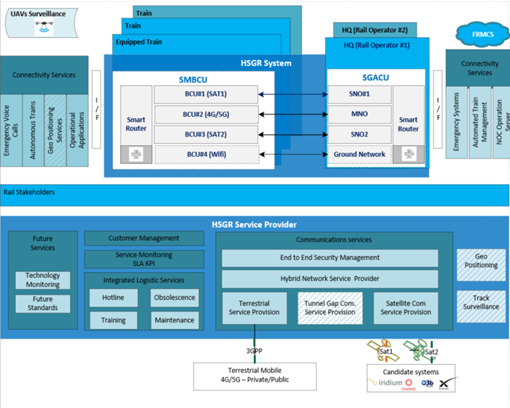
-
StatusCompleted
-
Status date2024-04-24
Hybrid Space-Ground Communication Network for European Rail Systems (HSGR) aims to overcome challenges in the Future Railway Mobile Communication System (FRMCS) implementation, thanks to the provision of a multi-bearer solution integrating heterogeneous communication technologies, envisaged to complement the rail operators’ existing GSM-R and 4G/5G networks for their safety critical and operational train connectivity. In this framework, Airbus’ bearer-agnostic solution that routes existing public/private and satellite communications/terrestrial networks according to the application detected will be adapted to the rail environment and tested on trains, before being commercialized in the years following project completion.
HSGR’s main challenges are to develop an evolving, bearer agnostic and fully redundant communication system with best-in class QoS for safety critical rail communications through:
- Achieving seamless hybrid connectivity while tackling the constraints of LEO Satcom which is still at an early stage for network mobility, in a context where the Rail industry has not yet set the pan-European standards of the Future Railway Mobile Communication System (FRMCS)
- Designing a system preventing loss of network due to electro-magnetic interferences with catenary towers and other obstacles
The Airbus solution offers the following benefits:
- Introducing satellite communication in the rail environment and thus develop new opportunities for the satellite world
- Reinforcing the guarantee of service for railway safety critical applications in providing a redundant Satcom terrestrial system offering the best available network in terms of availability, QoS and network segregation
- Being adaptable to the future technology evolutions thanks to an open system architecture
- Connecting secondary lines today without connectivity thanks to a far lower CAPEX than that of 5G, thus also enhancing both security and train connectivity
Contributing to the future of rail transport such as the autonomous trains in complementing the services provided by LTE services.
The end product is an end-to-end secure hybrid satcom-terrestrial communication system that is bearer agnostic and application driven. The product is scalable to allow rail operators to select the communication solution that meets their needs from the baseline smart routing module with applications such as geo-positioning, track surveillance up to a fully managed service including services such as SOC, NOC , Satcom capacity, etc.
The HSGR architecture is divided in two building blocks: a system and a catalogue of services.
The HSGR System is a full End to End hybrid communication solution composed of:
- A Secure Remote Multi-Bearer Communication Unit (SMBCU) routing the critical operational communications from the train to the Bearer Communication Unit (BCU)
- A Secure Ground Aggregation Communication Unit (SGACU) interfacing with the Satellite and Terrestrial Network Operators and the rail operations centres (HQ)
The HSGR managed service intends to offer a catalogue of added value services such as managed terrestrial and satellite communications, network service and security monitoring, ILS.
HSGR High Level Architecture View

The project is part of the Technology Phase with an incremental approach made of two phases from baseline concept to extended scope. The current ‘Step A’, is a proof-of-concept level study, including a pilot demonstration using Airbus’s mobile demonstration vehicle to ensure that the baseline rail use case scenarios have been covered. The purpose of the following ’Step B’ is to validate the system architecture, by testing the envisaged system functionalities and demonstrating end-to-end seamless IP connectivity through hybrid satellite-terrestrial networks in a full-scale rail testing environment thanks to the DB and SNCF train labs.
On 22th June 2023, the Consortium has performed a successful Live PoC demo demonstrating hybrid connectivity with smart routing between the LEO Starlink constellation and the public 5G network according to the link quality of each bearer vis à vis the application related routing rules.





